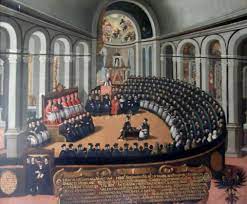 The 95 Theses, 1517
The 95 Theses, 1517
 Voltaire, 1694-1778
Voltaire, 1694-1778
 Council of Trent, 1545-1563
Council of Trent, 1545-1563
The reformation was a period of political turmoil in Europe. Martin Luther's 95
Theses in 1517 shook the world by directly challenging the Catholic Church. He
condemned certain practices and members of the church and created a new branch of
Christianity, leading to both more branches and mild reform within the Catholic Church.
Prelude
The Reformation was sparked by Martin Luther's 95 Theses. Discontent with certain
practices he viewed as corrupt, such as the sale of indulgences, Luther attacked
the Catholic Church with a fire, listing 95 reasons why it's behavior was against
the Bible. This led to the Reformation.
95 Theses & Reaction
Luther's 95 Theses shocked the world. It was the first time someone had dared to
challenge the Catholic Church, and they weren't going to allow it to happen. Luther
was exocommunicated in 1521 and went into hiding with one of his patrons. From there,
he continued to attack the church and promote Lutheranism, his new branch of
Christianity. Disillusioned with the growing corruptness of the church, many
converted to Lutheranism.
Council of Trent & Catholic Reforms
Seeing the growing movement towards Lutheranism, the Catholic Church attempted to
win back support from the people. From 1545-1563, the Council of Trent attempted to
institute reforms as part of the Catholic Reformation (or Counter-Reformation) to
mild success. Countries such as Spain and France remained Catholic, while Germany
and Switzerland were successes of the Reformation.
 The 95 Theses, 1517
The 95 Theses, 1517
 Voltaire, 1694-1778
Voltaire, 1694-1778
 Council of Trent, 1545-1563
Council of Trent, 1545-1563